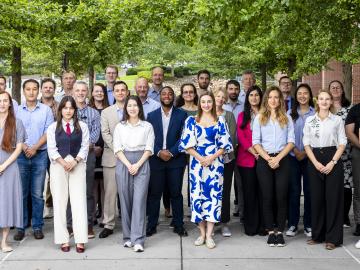
Filter News
Area of Research
- Advanced Manufacturing (7)
- Biological Systems (1)
- Biology and Environment (49)
- Building Technologies (2)
- Clean Energy (113)
- Computational Biology (2)
- Computational Engineering (1)
- Computer Science (3)
- Electricity and Smart Grid (3)
- Energy Sciences (1)
- Fuel Cycle Science and Technology (2)
- Functional Materials for Energy (1)
- Fusion and Fission (47)
- Fusion Energy (17)
- Isotope Development and Production (1)
- Isotopes (13)
- Materials (47)
- Materials for Computing (8)
- National Security (52)
- Neutron Science (22)
- Nuclear Science and Technology (39)
- Nuclear Systems Modeling, Simulation and Validation (1)
- Quantum information Science (2)
- Sensors and Controls (2)
- Supercomputing (44)
News Topics
- (-) Biomedical (61)
- (-) Education (5)
- (-) Fusion (59)
- (-) Grid (67)
- (-) National Security (73)
- (-) Nuclear Energy (111)
- (-) Security (26)
- (-) Space Exploration (25)
- (-) Sustainable Energy (130)
- 3-D Printing/Advanced Manufacturing (128)
- Advanced Reactors (35)
- Artificial Intelligence (102)
- Big Data (62)
- Bioenergy (92)
- Biology (101)
- Biotechnology (24)
- Buildings (67)
- Chemical Sciences (73)
- Clean Water (31)
- Climate Change (106)
- Composites (30)
- Computer Science (199)
- Coronavirus (46)
- Critical Materials (29)
- Cybersecurity (35)
- Decarbonization (85)
- Element Discovery (1)
- Emergency (2)
- Energy Storage (112)
- Environment (201)
- Exascale Computing (44)
- Fossil Energy (6)
- Frontier (46)
- High-Performance Computing (94)
- Hydropower (11)
- Irradiation (3)
- Isotopes (57)
- ITER (7)
- Machine Learning (51)
- Materials (149)
- Materials Science (149)
- Mathematics (10)
- Mercury (12)
- Microelectronics (4)
- Microscopy (51)
- Molten Salt (9)
- Nanotechnology (60)
- Net Zero (14)
- Neutron Science (139)
- Partnerships (51)
- Physics (64)
- Polymers (33)
- Quantum Computing (38)
- Quantum Science (72)
- Renewable Energy (2)
- Simulation (53)
- Software (1)
- Statistics (3)
- Summit (61)
- Transformational Challenge Reactor (7)
- Transportation (99)
Media Contacts

A study led by the Department of Energy’s Oak Ridge National Laboratory details how artificial intelligence researchers created an AI model to help identify new alloys used as shielding for housing fusion applications components in a nuclear reactor. The findings mark a major step towards improving nuclear fusion facilities.

A new technical collaboration program at the Department of Energy’s Oak Ridge National Laboratory will help businesses develop and launch electric grid innovations. Sponsored by the Transformer Resilience and Advanced Components program in DOE’s Office of Electricity, the initiative will provide companies with access to national laboratory resources, enabling them to capture market opportunities.

U2opia Technology has licensed Situ and Heartbeat, a package of technologies from the Department of Energy’s Oak Ridge National Laboratory that offer a new method for advanced cybersecurity monitoring in real time.
Summer interns at the Department of Energy’s Oak Ridge National Laboratory recently dove into various smart devices to better understand cybersecurity vulnerabilities posed by technology meant to simplify a user’s life.

Three flights, five thousand miles and half a dozen clearances and permissions stood between Tetiana Maltseva and the Department of Energy’s Oak Ridge National Laboratory. When she finally arrived at the lab to represent Ukraine at the 2024 Nuclear Energy Management School, her vision was clear.
After retiring from Y-12, Scott Abston joined the Isotope Science and Engineering Directorate to support isotope production and work with his former manager. He now leads a team maintaining critical equipment for medical and space applications. Abston finds fulfillment in mentoring his team and is pleased with his decision to continue working.

On Feb. 15, 2024, the one billionth item, also known as an “occupancy,” was scanned at the Port of Aqaba, Jordan, one of the early sites where radiation detection equipment was installed. This milestone shows the extent of countries committed to preventing the spread of radioactive material through the amount of data volunteered to ORNL for continuous improvement. As adversaries push the limits of smuggling dangerous material, this collaboration pushes back through science-backed analysis.

ORNL is the lead partner on five research collaborations with private fusion companies in the 2024 cohort of the Innovation Network for FUSion Energy, or INFUSE, program. These collaborative projects are intended to resolve technical hurdles and develop enabling technologies to accelerate fusion energy research in the private sector.

Researchers for the first time documented the specific chemistry dynamics and structure of high-temperature liquid uranium trichloride salt, a potential nuclear fuel source for next-generation reactors.

Elton Aba, an intern at the Department of Energy’s Oak Ridge National Laboratory, collaborated with researchers to explore an intriguing intersection: how biology can inform cybersecurity. Aba shared some of his findings on how biomimicry could help secure our nation’s critical infrastructure.


